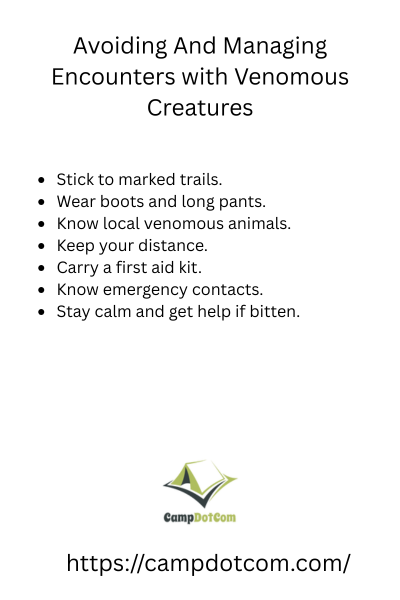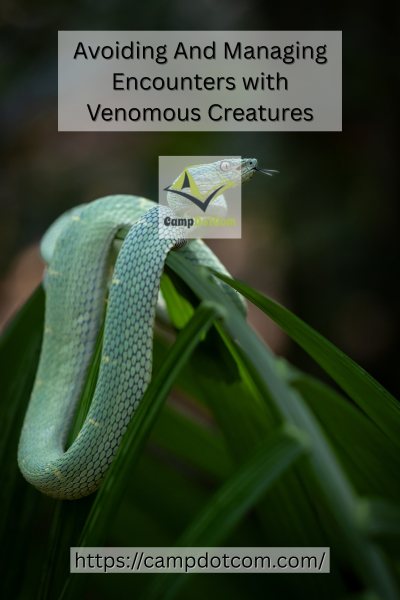Avoiding and managing encounters with venomous creatures is one of those skills you hope you never need, but when you do, you will be glad you picked it up.
Whether you are hiking, camping, or just exploring a patch of wild land, these critters do not exactly check your schedule before making an appearance.
I have had my share of “oh no” moments with nature’s less cuddly residents. Once, while on a trail in the Arizona desert, I nearly stepped on a rattlesnake because I was too busy admiring the sunset. My heart did a full cardio workout in two seconds flat.
As an Amazon Associate, I earn from qualifying purchases. Some of the links in this article are affiliate links. This means that, at zero cost to you, I will earn an affiliate commission if you click through the link and finalize a purchase.
That is when I realized: it is not just about spotting them, it is about knowing how to avoid them entirely and how to react if you do meet one.
Read More About Avoiding And Managing Encounters with Venomous Creatures

Know Your Local Venomous Wildlife
Before you head into the great outdoors, take a few minutes to learn which venomous creatures call the area home. Rattlesnakes, copperheads, black widows, scorpions—different regions have their own roll call of “don’t touch” animals.
Why bother? Because knowing what’s out there means you can recognize the signs and habitats to watch out for. If you know that a certain snake loves sunny rocks in the morning, you’ll keep your eyes peeled when you’re scrambling over boulders.
More Things to Know About Avoiding And Managing Encounters with Venomous Creatures

Dress Like You Mean Business
Avoiding and managing encounters with venomous creatures often starts with what you are wearing. Long pants, thick socks, and sturdy boots are like body armor for your lower half.
They will not make you invincible, but they can make the difference between a scare and a hospital visit.
When I swapped out my old hiking sneakers for boots, I immediately noticed fewer close calls with unseen critters. Boots do not just protect, you walk more confidently because you are not as worried about what might be slithering around.
If you are really worried about going into an area with lots of snakes, get a pair of Snake Gaiters to protect your ankles and legs.
Give Them Their Space
The easiest way to manage a venomous creature encounter is to avoid having one in the first place. It sounds obvious, but you might be surprised how many people lean in for a closer look.
If you see a snake on the trail, stop and wait for it to move on. Do not prod it with a stick (seriously, why do people do this?). The same goes for spiders, scorpions, or anything else with venom. They are not looking for a fight, but they will defend themselves if they feel cornered.
Stay Alert, Especially in “High-Risk” Spots
Avoiding and managing encounters with venomous creatures often comes down to simply paying attention. That means watching where you put your hands and feet—no reaching blindly into crevices or stepping over logs without looking first.
These animals love shady, hidden spots during hot days and may come out in the cooler evening hours. If you are moving camp or gathering firewood at dusk, be extra careful. Headlamps are your best friend after dark, and spotting that glint of eyes in time can make all the difference.
What To Do If You Cross Paths
Let’s say you are walking and suddenly there it is, a venomous creature right in your path. The key here is to stay calm. It is easier said than done when your brain is screaming “Run!” but panicking just makes things worse.
Stop moving. Slowly back away. Give the animal an escape route. Most will leave you alone if they do not feel trapped. The real danger happens when people try to handle the situation aggressively, because that is when the animal feels it has no choice but to strike.
If You Get Bitten or Stung
Despite your best efforts, accidents can happen. If a venomous creature bites or stings you, do not try old fashioned remedies like sucking out the venom or applying a tourniquet. You will likely cause more harm than good.
Instead, keep the affected limb still, call emergency services, and get to medical care as quickly as possible. If it is safe, take a photo of the animal from a distance as this can help doctors give the right treatment.
And no, you do not have to kill the animal for identification purposes. Let it go about its business. You have your own business to deal with.
My “Almost” Story
One evening while camping in Florida, I went to shake out my sleeping bag before crawling in. Out plopped a small, very annoyed coral snake. My first thought was, “That’s pretty,” followed by “That’s extremely bad.” I slowly stepped back, gave it time to slither off, and then zipped my tent like Fort Knox for the rest of the trip. Moral of the story: always check your gear.
Staying Prepared for Venomous Creature Encounters Outdoors
Avoiding and managing encounters with venomous creatures is not about living in fear, it is about being prepared. Learn what is out there, respect their space, and stay alert. You will not only protect yourself but also allow these creatures to live their lives without unnecessary conflict.
Nature is wild, unpredictable, and sometimes dangerous, but with the right mindset and habits, you can enjoy every adventure without turning it into a survival story.
